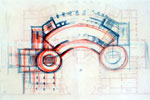| [images and
captions added by this website]Montreal, Canada, Wednesday, July 13, 2005 Hitler sketches
on the block Canadian
Jewish Congress lashes out at Montreal auction of
architectural drawings by Tia
Goldenberg
The Gazette ALONG with the bright and
flowery Andy Warhol piece and the untitled
Joan Miro, another set of works will be sold
at an auction in Montreal on Monday. Their creator:
Adolf
Hitler. Four architectural sketches by
[sic. this Website
disagrees] the German dictator were
consigned to the Iegor-Hotel des Encans auction
house by an anonymous vendor about a month ago.
 The
drawings are to be auctioned in separate lots
alongside two signed greeting cards sent to
Hitler's chief architect, Albert Speer - one
from New Year's Day 1935 and the other from
Christmas 1938. The
drawings are to be auctioned in separate lots
alongside two signed greeting cards sent to
Hitler's chief architect, Albert Speer - one
from New Year's Day 1935 and the other from
Christmas 1938. Auctioneer Iegor de Saint Hippolyte said
he's too superstitious to put a value on the works
before the auction, but said they won't be the
highest-selling lots among the 300 works being
sold.  He
also said the simple ink and charcoal drawings,
three of which appear in the book Adolf
Hitler, historian John Toland's
pictorial documentary of the dictator's life, have
little or no political significance. He
also said the simple ink and charcoal drawings,
three of which appear in the book Adolf
Hitler, historian John Toland's
pictorial documentary of the dictator's life, have
little or no political significance.
"If I was selling (Hitler's autobiography)
Mein Kampf or another very political work,
there would be some neo-Nazi interest in buying
it," de Saint Hippolyte said. "But this is not so political."  The
drawings, two of which depict the Linz opera house
in Austria and Hitler's country home the Berghof,
don't look like typical Third Reich propaganda nor
do they bear discriminatory statements. The
drawings, two of which depict the Linz opera house
in Austria and Hitler's country home the Berghof,
don't look like typical Third Reich propaganda nor
do they bear discriminatory statements.
But the politics of these pieces does not lie in
what they are, one historian said, but what they
convey. "Architecture was a major factor in the
propaganda of the Third Reich," said Peter
Hoffmann, a McGill University history professor
specializing in German resistance against National
Socialism. Hitler wanted to build monuments and edifices
throughout what he hoped would be his 1,000-year
empire. Like Greek and Roman ruins, they would
serve as testimony to the great power of the
regime, Hoffmann said. Besides trying to redesign Berlin with grand
avenues, stately assembly halls and towering
government buildings, Hitler and Speer wanted to
rebuild Linz, Hitler's home town, as well.  The
sketch of the opera house, originally by Speer, was
corrected by Hitler. The
sketch of the opera house, originally by Speer, was
corrected by Hitler.
"It gives insight into the man. It shows how
much he wanted to manipulate things," de Saint
Hippolyte said. Hitler's art has been sold before. In Britain in
1997, a watercolour painting by the Nazi leader was
sold to an anonymous buyer for about $9,000 - about
five times its estimated
value. Hitler had dreamed of becoming an artist
before he entered politics. Max Bernard, honorary vice-president of the
Canadian
Jewish Congress's Quebec region, said the
political aspect of the architecture is evident in
the drawings.  "It
is a (sketch of a) monument of the Nazi regime,
which in itself is offensive." "It
is a (sketch of a) monument of the Nazi regime,
which in itself is offensive."
The congress has lashed out at the selling of
the drawings. Bernard said if they have
architectural worth, they should be
[Website comment:
hidden] in an archive, where
scholars and architects can study them for research
purposes. "The congress is certainly not
suggesting that these things should be destroyed,
but that's where they belong," he said. Of the 8,000 invitees to the auction, de Saint
Hippolyte said, he expects more than 150 people to
show and another 200 to place absentee bids. The
patrons are mostly private collectors and archive
directors. The kind of person who might buy such a piece
can range from an architecture and history buff to
a collector of Nazi and war memorabilia, Hoffmann
said. It is these private collectors who worry the
Canadian
Jewish Congress. They "might derive some sort
of pleasure out of having something created by
someone of that notoriety," Bernard said. He said he sees no other value in the
pieces. "They're being sold alongside the works of
legitimate artists, who I think also might be a
little disappointed at that." Heinz Becker, an administrator at
Montreal's Goethe Institute, a German
[Government]
cultural organization, also sees little value in
the sketches. "If there would be a piece of paper signed by
him, ordering the death of so many people, that
would be of historical value. But a design like
that -- a house with a chimney -- I don't see what
kind of value it could have," Becker said. Hoffmann noted the concerns of the Canadian
Jewish Congress were legitimate. "The concern is that it may make
Hitler appear as less than a monster if he was
interested in architecture," he said. But, Hoffmann added, there's already
overwhelming evidence showing Hitler's evil
character, so documents like these must be in the
public domain. "It's important to keep a historical record.
That's simply important in its own right," Hoffmann
said. "No historical record can be
ignored." © The Gazette
(Montreal) 2005
 Hitler
Sketches, cards, net $32,000 at Montreal
Auction
Hitler
Sketches, cards, net $32,000 at Montreal
Auction
|